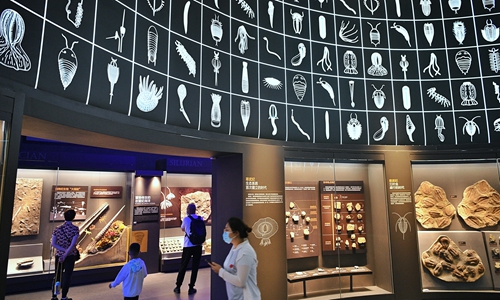
Decorations featuring sharks and other oceanic species at the National Maritime Museum of China Photo: CNS
About 160 kilometers away from Beijing, a marine culture haven provides visitors an opportunity to explore the evolving relationship between mankind and ocean while closely observing a diverse range of marine animals.
Located in North China's Tianjin Municipality's Binhai New Area, the National Maritime Museum of China (NMMC) and Tianjin Haichang Polar Ocean Park (THPOP) are two landmarks that offer people an extravaganza of marine culture education.
Designed by Australia's Cox Architecture and Tianjin Architecture Design Institute (TADI), the NMMC looks like four giant metal wings stretching out to overlook the Bohai Bay. Covering an area of 80,000 square meters, the imposing modern complex houses six exhibition sections and 15 interconnected halls. The museum is approximately two and a half times larger than the Sydney Opera House in Australia.
Liu Jingliang, honorary president of TADI, said that the purpose of the museum is to raise people's awareness about the ocean and that the world-class infrastructure combines elements of history, culture and art.
Education instituteSince the museum's soft opening in May 2019, the three-story building has become a marine education institute in China and a cultural phenomenon on the global stage. It's the only national maritime museum in China.
A museum guide told the Global Times that schools and universities in Tianjin have moved their classrooms into the museum throughout the year, carrying out workshops on different topics.
"It offers visitors an immersive experience while showcasing the museum's extensive collection, research, and educational resources on marine topics," said the guide.
With its extensive collection and various workshops, the museum is committed to becoming an integral part of the national public cultural system and an authoritative collection and protection center for marine cultural relics, a marine civilization research center and a marine cultural exchange center, according to the museum.
The museum opens to the public from Tuesday to Sunday free of charge and there are plenty of parking spaces in front of the building. Visitors can also go to the museum by subway and bus but are required to make a reservation on its official WeChat account beforehand.
Some of the permanent exhibitions include "the ancient ocean," "ocean today," "journey of discovery," "the age of the dragon," "ocean and astronomy" and "happy ocean."
Based on the evolutionary sequence of geological history, "the ancient ocean" on the first floor shows the 4.6 billionyear evolution of the oceans. Precious arrays of fossils will give you insights into the earliest formation of the ocean, the emergence and extinction of various ancient marine creatures, the formation and changes of the modern ocean, as well as predictions and prospects for the future of the ocean.
The fossilized specimens include the oldest cyanobacteria, the largest trilobite, and the most complete ichthyosaur as well as some dinosaur fossils. These fossils not only show the diversity and evolution of marine life, but also reflect various major events in the history of the Earth, such as plate movements, continental drift, climate change, and mass extinctions.
By means of models and interactive equipment, this hall helps you better understand that the ocean is the cradle of life on Earth and a witness to its history.
Children will marvel at the huge specimens of whale sharks, giant squids, a pregnant hammerhead shark and a dazzling collection of invertebrates when strolling into the "ocean today" on the third floor.
Displaying the relationship between humans and the ocean as the main theme, it is divided into four sections: marine resources, marine environment, marine disasters, and marine governance. The real fishing gears, oil field equipment and deep-sea detectors allow you to understand how humans develop and utilize marine resources. It also shows the impact of human activities on the marine environment, such as the greenhouse effect, acidification, pollution and overfishing.
The interactive scenes give you a glimpse of the power and harm of ocean disasters, such as hurricanes, tsunamis, storm surges, etc. It also introduces the efforts and achievements made by the international community and the Chinese government in ocean governance, such as formulating and enforcing laws and regulations, establishing and participating in various organizations, conducting and supporting various scientific research and educational activities.
Buzzing with excitementTHPOP, a marine-themed amusement park featuring animal exhibits and shows, is about a 20-minute drive from the museum. Please check the daily schedule for dolphin and sea lion performances when you enter the park.
It is home to more than 30,000 polar and sea creatures, including polar bears, sharks, jellyfish, seals, penguins, sea lions and beluga whales. Visitors have a chance to feed the seals and sea lions at an outdoor pool.
A teacher who took her students from Tianjin No. 11 Middle School to the show told the Global Times that the ocean park is a top destination for students in Tianjin.
"Especially after the COVID-19, nearly all schools across Tianjin organized trips to the park as we want students to enjoy more outdoor activities and have fun," said the teacher.
The crowd buzzed with excitement as children wowed when dolphins leaped out of the water. Under the instructions of four trainers, they performed a series of intricate tricks, flipping and spinning in the air.
Another popular spot in the park is the fish tunnel where schools of colorful fish swim above the visitors' heads when you stroll through. A hall is particularly designed to display nearly one-tenth of the world's jellyfish species in colorfully-lit tanks.
There is no better way to end the marine culture journey than going to the seaside. There are several established seaside parks in Binhai where children will have a blast in finding crabs hidden under the rocks on the beach at low tide.

Visitors at the National Maritime Museum of China Photo: CNS